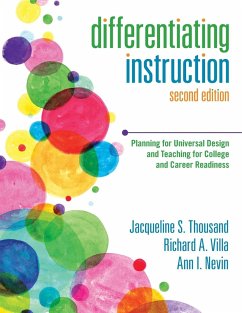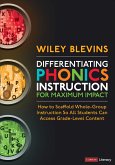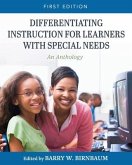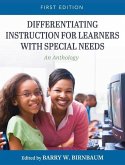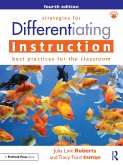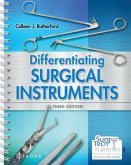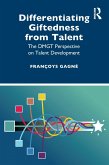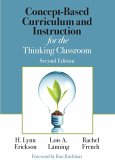Jacqueline S. Thousand, Richard A. Villa, Ann I. Nevin
Differentiating Instruction
Planning for Universal Design and Teaching for College and Career Readiness
Jacqueline S. Thousand, Richard A. Villa, Ann I. Nevin
Differentiating Instruction
Planning for Universal Design and Teaching for College and Career Readiness
- Broschiertes Buch
- Merkliste
- Auf die Merkliste
- Bewerten Bewerten
- Teilen
- Produkt teilen
- Produkterinnerung
- Produkterinnerung
A guide to leaving no child behind. It is your one-stop resource for differentiated instruction. Whether you're new to the concept or just looking to improve your approach, it helps you discover how Universal Design for Learning (UDL) and retrofitting can help you adapt general education curriculum to diverse learning styles.
Andere Kunden interessierten sich auch für
![Differentiating Phonics Instruction for Maximum Impact Differentiating Phonics Instruction for Maximum Impact]() Wiley BlevinsDifferentiating Phonics Instruction for Maximum Impact28,99 €
Wiley BlevinsDifferentiating Phonics Instruction for Maximum Impact28,99 €![Differentiating Instruction for Learners with Special Needs Differentiating Instruction for Learners with Special Needs]() Differentiating Instruction for Learners with Special Needs160,99 €
Differentiating Instruction for Learners with Special Needs160,99 €![Differentiating Instruction for Learners with Special Needs: An Anthology Differentiating Instruction for Learners with Special Needs: An Anthology]() Differentiating Instruction for Learners with Special Needs: An Anthology239,99 €
Differentiating Instruction for Learners with Special Needs: An Anthology239,99 €![Strategies for Differentiating Instruction Strategies for Differentiating Instruction]() Julia Link RobertsStrategies for Differentiating Instruction26,99 €
Julia Link RobertsStrategies for Differentiating Instruction26,99 €![Differentiating Surgical Instruments Differentiating Surgical Instruments]() Colleen J. RutherfordDifferentiating Surgical Instruments105,99 €
Colleen J. RutherfordDifferentiating Surgical Instruments105,99 €![Differentiating Giftedness from Talent Differentiating Giftedness from Talent]() Françoys GagnéDifferentiating Giftedness from Talent44,99 €
Françoys GagnéDifferentiating Giftedness from Talent44,99 €![Concept-Based Curriculum and Instruction for the Thinking Classroom Concept-Based Curriculum and Instruction for the Thinking Classroom]() H. Lynn EricksonConcept-Based Curriculum and Instruction for the Thinking Classroom41,99 €
H. Lynn EricksonConcept-Based Curriculum and Instruction for the Thinking Classroom41,99 €-
-
-
A guide to leaving no child behind. It is your one-stop resource for differentiated instruction. Whether you're new to the concept or just looking to improve your approach, it helps you discover how Universal Design for Learning (UDL) and retrofitting can help you adapt general education curriculum to diverse learning styles.
Hinweis: Dieser Artikel kann nur an eine deutsche Lieferadresse ausgeliefert werden.
Hinweis: Dieser Artikel kann nur an eine deutsche Lieferadresse ausgeliefert werden.
Produktdetails
- Produktdetails
- Verlag: SAGE Publications Inc
- 2 Revised edition
- Seitenzahl: 360
- Erscheinungstermin: 5. Dezember 2014
- Englisch
- Abmessung: 280mm x 216mm x 19mm
- Gewicht: 1002g
- ISBN-13: 9781483344454
- ISBN-10: 1483344452
- Artikelnr.: 41251955
- Herstellerkennzeichnung
- Libri GmbH
- Europaallee 1
- 36244 Bad Hersfeld
- gpsr@libri.de
- Verlag: SAGE Publications Inc
- 2 Revised edition
- Seitenzahl: 360
- Erscheinungstermin: 5. Dezember 2014
- Englisch
- Abmessung: 280mm x 216mm x 19mm
- Gewicht: 1002g
- ISBN-13: 9781483344454
- ISBN-10: 1483344452
- Artikelnr.: 41251955
- Herstellerkennzeichnung
- Libri GmbH
- Europaallee 1
- 36244 Bad Hersfeld
- gpsr@libri.de
Jacqueline S. Thousand, Ph.D., is Professor Emerita at California State University San Marcos, where she designed and coordinated special education professional preparation and Master's degree programs in the College of Education, Health, and Human Services. She previously taught at the University of Vermont, where she directed Inclusion Facilitator and Early Childhood Special Education graduate and postgraduate programs and coordinated federal grants, which, in the early 1980s, pioneered the inclusion of students with moderate and severe disabilities in general education classrooms of their local schools. Prior to university teacher, Dr. Thousand served as a special educator in Chicago area and Atlanta public schools and as the coordinator of early childhood special education services for children ages 3 through 6 in the Burlington, Vermont area. Dr. Thousand is a nationally known teacher, author, systems change consultant, and disability rights and inclusive education advocate. She is the author of 21 books and numerous research articles and chapters on issues related to inclusive education, organizational change strategies, differentiated instruction and universal design, co-teaching and collaborative teaming, cooperative group learning, creative problem solving, positive behavioral supports, and, now, culturally proficiency special education. Dr. Thousand is actively involved in international teacher education and inclusive education endeavors and serves on the editorial boards of several national and international journals. Learn more about Richard Villa′s PD offerings Richard A. Villa is president of Bayridge Consortium, Inc. His primary field of expertise is the development of administrative and instructional support systems for educating all students within general education settings. Villa is recognized as an educational leader who inspires and works collaboratively with others to implement current and emerging exemplary educational practices. His work has resulted in the inclusion of children with intensive cognitive, physical, and emotional challenges as full members of the general education community in the school districts where he has worked and consulted. Villa has been a classroom teacher, special education administrator, pupil personnel services director, and director of instructional services and has authored 4 books and over 70 articles and chapters. Known for his enthusiastic, humorous style, Villa has presented at international, national, and state educational conferences and has provided technical assistance to departments of education in the United States, Canada, Vietnam, and Honduras and to university personnel, public school systems, and parent and advocacy organizations. Ann I. Nevin is professor emerita at Arizona State University and visiting professor at Florida International University. The author of books, research articles, and numerous chapters, Nevin is recognized for her scholarship and dedication to providing meaningful, practice-oriented, research-based strategies for teachers to integrate students with special learning needs. Since the 1970s, she has co-developed various innovative teacher education programs that affect an array of personnel, including the Vermont Consulting Teacher Program, Collaborative Consultation Project Re-Tool sponsored by the Council for Exceptional Children, the Arizona State University program for special educators to infuse self-determination skills throughout the curriculum, and the Urban SEALS (Special Education Academic Leaders) doctoral program at Florida International University. Her advocacy, research, and teaching spans more than 38 years of working with a diverse array of people to help students with disabilities succeed in normalized school environments. Nevin is known for action-oriented presentations, workshops, and classes that are designed to meet the individual needs of participants by encouraging introspection and personal discovery for optimal learning.
A Letter to Our Readers
Acknowledgments
About the Authors
1. Why Differentiation of Instruction Now?
What Differentiated Instruction IS (and What It Is NOT)
Rationales for Differentiated Instruction
Rationale #1: To Meet Needs of Diverse Learners
Rationale #2: To Meet Legal Mandates
Rationale #3: To Be Ethical in Implementing Democratic Values
Rationale #4: To Dispel Myths About Students
Rationale #5: To Be Effective Teachers
Retrofit and Universal Design: Two Approaches to Differentiated Instruction
Systemic Support for Differentiated Instruction
Overview of the Book
2. Accessing the General Education Curriculum Through a Retrofit Framework
What Is the Retrofit Approach?
Scenario #1: Elementary Science and Social Studies
Scenario #2: Middle Level Mathematics
Scenario #3: Middle Level Science
Scenario #4: High School Language Arts
What Do You Know About Retrofitting as a Way to Differentiate Instruction?
3. Access to Curriculum Through Universal Design for Learning
The UDL Cycle for Differentiating Content, Product, and Process
Design Point #1: Gathering Facts About the Learners
Design Point #2: Differentiate Content and Materials
Design Point #3: Product or Differentiate How Students Show What They Know
Design Point #4: Differentiate Instructional Processes
Pause and Reflect About Student-Specific Teaching Strategies and Supports
Putting It All Together With the Universal Design Lesson Plan
4. Gathering Facts About the Learners
Record Review
Family-Centered and Culturally Responsive Fact Gathering
Interest Inventories
Learning Preferences Information
Learning and Thinking Styles
Multiple Intelligences
Data-Based Observations Including Functional Behavioral Assessments and
Cooperative Group Monitoring
Data-Based Observations
Functional Behavioral Assessment
Monitoring Cooperative Group Learning
Curriculum-Based Assessments
Making Action Plans (MAPs)
Disability-Specific Information
Co-Teacher Roles in Gathering Facts About the Learners
Pause and Reflect
5. Differentiating Access to the Content of Learning
What Is Content?
Ways to Promote Access to Content
Taxonomies and Objectives: Using and Not Abusing Them
Layered Curriculum and Levels of Participation
Differentiating Content Using Graphic Organizers and Educational Technology
Differentiating Content With Culturally and Linguistically Responsive
Techniques
Involving Students in Determining Content
Co-Teacher Roles in Differentiating Content
Pause and Reflect
6. Differentiating and Assessing the Products of Learning
Why Differentiate Assessment in a Climate of High-Stakes Testing?
Using Culturally Responsive Techniques to Differentiate and Assess the
Products of Learning
Taxonomy and Learning Preferences Frameworks to Differentiate Products and
Assessment
Using Bloom's Taxonomy to Differentiate Products and Assessment
Using Learning Preferences Frameworks to Differentiate Products and
Assessment
Using Bloom's Taxonomy and Multiple Intelligences Theory to Differentiate
Products and Assessment
Scaffolding and Curriculum-Based Assessments
Scaffolding as Formative Assessment
Curriculum-Based Assessment
Differentiating How Teachers Grade Products
Alternatives to Norm-Referenced Grading Procedures
Adapting Criterion-Referenced Grading Systems
Self-Referenced Systems
Co-Teacher Roles in Differentiating Products of Learning
Pause and Reflect
7. Differentiating the Instructional Processes
The Complexities of the Process of Instruction (Graphic Organizer)
Instructional Formats
Instructional Arrangements
Highlights on Cooperative Learning
A Focus on Cooperative Strategies for Emerging and Struggling Readers
A Highlight on Peer Tutors and Partner Learning Arrangements
Instructional Strategies
Using Taxonomies
Applying Concepts From Learning Preferences Frameworks
Integrating the Arts
Social and Physical Environment
Co-Teaching Approaches
Pause and Reflect
8. Collaborative Planning and Evaluation for Differentiated Instruction
The Rationale and Benefits of Collaborative Planning and Teaching
Effective and Efficient Use of Planning and Evaluation Time
Development of Relationships Among Team Members: It's a Process!
Skills for Building Trust and Establishing Team Norms
Communication and Leadership Skills
Creative Problem-Solving Skills
Conflict Resolution Skills
Are We Really an Effective Planning Team?
9. Co-Teaching to Deliver Differentiated Instruction
Why Collaborate to Co-Teach?
Research Base for Co-Teaching
Who Can Be Co-Teachers?
Four Approaches to Co-Teaching
Supportive Co-Teaching
Parallel Co-Teaching
Complementary Co-Teaching
Team Co-Teaching
Questions About Co-Teaching to Differentiate Instruction
10. UDL Lesson Planning Cycle to Differentiate Instruction in Action: A
Fourth-Grade Social Studies Unit
Setting the Context
Co-Teacher Professional Development Activities
Multiple Methods for Accessing Content
Differentiating the Products (Outcomes) of Learning
Differentiating the Instructional Processes
Instructional Format
Instructional Arrangements
Instructional Strategies
Social and Physical Environment
Co-Teaching Approaches
Implementing the UDL Plan
Using the Lesson Plan Template
11. UDL Lesson Planning Cycle to Differentiate Instruction in Action:
Middle Level Mathematics
Who Are the Teachers?
Professional Development Activities
Gathering (New) Facts About the Learners
Multiple Methods for Accessing the Content for Algebra I
Differentiating the Products (Outcomes) of Learning
Differentiating the Instructional Processes
Group Investigation
Cognitively Guided Instruction
English Language Learner Techniques
Implementing the UDL Plan
Using the Universal Design Lesson Plan Template
12. UDL Lesson Planning Cycle to Differentiate Instruction in Action:
Middle Level Science
Who Are the Teachers?
Planning to Change From a Retrofit Approach to a Universal Design Approach
Gathering (Additional) Facts About the Learners
Pause and Reflect: Tina
Planning Prior to the Lesson
Planning to Differentiate Content and Materials
Planning to Differentiate Products
Planning to Differentiate the Process of Learning
Finalizing the Lesson Plan
Differentiation in Action in the Class
Reflection
13. UDL Lesson Planning Cycle to Differentiate Instruction in Action: High
School Language Arts
Who Are the Teachers?
Co-Teacher Professional Development Activities
Gathering Facts About the Learners
Differentiating the Content and Materials
Key Ideas and Details
Craft and Structure
Range of Reading and Level of Text Complexity
Differentiating the Product
Pause and Reflect
Differentiating the Process
Co-Teacher Roles
The Planned Lesson
Before the Lesson
The Planned Instructional Sequence
Pause and Reflect
14. UDL Lesson Planning Cycle to Differentiate Instruction in Action: High
School Mathematics
Who Are the Teachers?
Co-Teacher Collaborative Planning and Professional Development Activities
Gathering Facts About the Learners
Anticipating Learners' Interests, Learning Preferences, Skills, and
Conceptual Understanding
Multiple Methods for Accessing the Content of Algebra II
Unit Theme: Reasoning and Sensemaking
Standards Addressed in the Unit
Differentiating the Product: Multiple Methods to Demonstrate Unit
Objectives
Implementation
Assessment of Prior Knowledge/Mastery
Differentiating the Process of Instruction
Planning for Differentiation to Include Evidence-Based Strategies
Implementing Differentiated Instructional Processes
Using the Lesson Plan Template
Reflections
Reflections on Facts About the Learners
Reflections on Content and Materials Differentiation
Reflections on Product and Assessment Differentiation
Reflections on Instructional Process Differentiation
Peer Observer Feedback and Future Goals
15. Epilogue: Pause and Reflect
Values and Assumptions About Students
Values and Assumptions About Adults
Why Explain Values and Assumptions?
References
Resources
Index
Acknowledgments
About the Authors
1. Why Differentiation of Instruction Now?
What Differentiated Instruction IS (and What It Is NOT)
Rationales for Differentiated Instruction
Rationale #1: To Meet Needs of Diverse Learners
Rationale #2: To Meet Legal Mandates
Rationale #3: To Be Ethical in Implementing Democratic Values
Rationale #4: To Dispel Myths About Students
Rationale #5: To Be Effective Teachers
Retrofit and Universal Design: Two Approaches to Differentiated Instruction
Systemic Support for Differentiated Instruction
Overview of the Book
2. Accessing the General Education Curriculum Through a Retrofit Framework
What Is the Retrofit Approach?
Scenario #1: Elementary Science and Social Studies
Scenario #2: Middle Level Mathematics
Scenario #3: Middle Level Science
Scenario #4: High School Language Arts
What Do You Know About Retrofitting as a Way to Differentiate Instruction?
3. Access to Curriculum Through Universal Design for Learning
The UDL Cycle for Differentiating Content, Product, and Process
Design Point #1: Gathering Facts About the Learners
Design Point #2: Differentiate Content and Materials
Design Point #3: Product or Differentiate How Students Show What They Know
Design Point #4: Differentiate Instructional Processes
Pause and Reflect About Student-Specific Teaching Strategies and Supports
Putting It All Together With the Universal Design Lesson Plan
4. Gathering Facts About the Learners
Record Review
Family-Centered and Culturally Responsive Fact Gathering
Interest Inventories
Learning Preferences Information
Learning and Thinking Styles
Multiple Intelligences
Data-Based Observations Including Functional Behavioral Assessments and
Cooperative Group Monitoring
Data-Based Observations
Functional Behavioral Assessment
Monitoring Cooperative Group Learning
Curriculum-Based Assessments
Making Action Plans (MAPs)
Disability-Specific Information
Co-Teacher Roles in Gathering Facts About the Learners
Pause and Reflect
5. Differentiating Access to the Content of Learning
What Is Content?
Ways to Promote Access to Content
Taxonomies and Objectives: Using and Not Abusing Them
Layered Curriculum and Levels of Participation
Differentiating Content Using Graphic Organizers and Educational Technology
Differentiating Content With Culturally and Linguistically Responsive
Techniques
Involving Students in Determining Content
Co-Teacher Roles in Differentiating Content
Pause and Reflect
6. Differentiating and Assessing the Products of Learning
Why Differentiate Assessment in a Climate of High-Stakes Testing?
Using Culturally Responsive Techniques to Differentiate and Assess the
Products of Learning
Taxonomy and Learning Preferences Frameworks to Differentiate Products and
Assessment
Using Bloom's Taxonomy to Differentiate Products and Assessment
Using Learning Preferences Frameworks to Differentiate Products and
Assessment
Using Bloom's Taxonomy and Multiple Intelligences Theory to Differentiate
Products and Assessment
Scaffolding and Curriculum-Based Assessments
Scaffolding as Formative Assessment
Curriculum-Based Assessment
Differentiating How Teachers Grade Products
Alternatives to Norm-Referenced Grading Procedures
Adapting Criterion-Referenced Grading Systems
Self-Referenced Systems
Co-Teacher Roles in Differentiating Products of Learning
Pause and Reflect
7. Differentiating the Instructional Processes
The Complexities of the Process of Instruction (Graphic Organizer)
Instructional Formats
Instructional Arrangements
Highlights on Cooperative Learning
A Focus on Cooperative Strategies for Emerging and Struggling Readers
A Highlight on Peer Tutors and Partner Learning Arrangements
Instructional Strategies
Using Taxonomies
Applying Concepts From Learning Preferences Frameworks
Integrating the Arts
Social and Physical Environment
Co-Teaching Approaches
Pause and Reflect
8. Collaborative Planning and Evaluation for Differentiated Instruction
The Rationale and Benefits of Collaborative Planning and Teaching
Effective and Efficient Use of Planning and Evaluation Time
Development of Relationships Among Team Members: It's a Process!
Skills for Building Trust and Establishing Team Norms
Communication and Leadership Skills
Creative Problem-Solving Skills
Conflict Resolution Skills
Are We Really an Effective Planning Team?
9. Co-Teaching to Deliver Differentiated Instruction
Why Collaborate to Co-Teach?
Research Base for Co-Teaching
Who Can Be Co-Teachers?
Four Approaches to Co-Teaching
Supportive Co-Teaching
Parallel Co-Teaching
Complementary Co-Teaching
Team Co-Teaching
Questions About Co-Teaching to Differentiate Instruction
10. UDL Lesson Planning Cycle to Differentiate Instruction in Action: A
Fourth-Grade Social Studies Unit
Setting the Context
Co-Teacher Professional Development Activities
Multiple Methods for Accessing Content
Differentiating the Products (Outcomes) of Learning
Differentiating the Instructional Processes
Instructional Format
Instructional Arrangements
Instructional Strategies
Social and Physical Environment
Co-Teaching Approaches
Implementing the UDL Plan
Using the Lesson Plan Template
11. UDL Lesson Planning Cycle to Differentiate Instruction in Action:
Middle Level Mathematics
Who Are the Teachers?
Professional Development Activities
Gathering (New) Facts About the Learners
Multiple Methods for Accessing the Content for Algebra I
Differentiating the Products (Outcomes) of Learning
Differentiating the Instructional Processes
Group Investigation
Cognitively Guided Instruction
English Language Learner Techniques
Implementing the UDL Plan
Using the Universal Design Lesson Plan Template
12. UDL Lesson Planning Cycle to Differentiate Instruction in Action:
Middle Level Science
Who Are the Teachers?
Planning to Change From a Retrofit Approach to a Universal Design Approach
Gathering (Additional) Facts About the Learners
Pause and Reflect: Tina
Planning Prior to the Lesson
Planning to Differentiate Content and Materials
Planning to Differentiate Products
Planning to Differentiate the Process of Learning
Finalizing the Lesson Plan
Differentiation in Action in the Class
Reflection
13. UDL Lesson Planning Cycle to Differentiate Instruction in Action: High
School Language Arts
Who Are the Teachers?
Co-Teacher Professional Development Activities
Gathering Facts About the Learners
Differentiating the Content and Materials
Key Ideas and Details
Craft and Structure
Range of Reading and Level of Text Complexity
Differentiating the Product
Pause and Reflect
Differentiating the Process
Co-Teacher Roles
The Planned Lesson
Before the Lesson
The Planned Instructional Sequence
Pause and Reflect
14. UDL Lesson Planning Cycle to Differentiate Instruction in Action: High
School Mathematics
Who Are the Teachers?
Co-Teacher Collaborative Planning and Professional Development Activities
Gathering Facts About the Learners
Anticipating Learners' Interests, Learning Preferences, Skills, and
Conceptual Understanding
Multiple Methods for Accessing the Content of Algebra II
Unit Theme: Reasoning and Sensemaking
Standards Addressed in the Unit
Differentiating the Product: Multiple Methods to Demonstrate Unit
Objectives
Implementation
Assessment of Prior Knowledge/Mastery
Differentiating the Process of Instruction
Planning for Differentiation to Include Evidence-Based Strategies
Implementing Differentiated Instructional Processes
Using the Lesson Plan Template
Reflections
Reflections on Facts About the Learners
Reflections on Content and Materials Differentiation
Reflections on Product and Assessment Differentiation
Reflections on Instructional Process Differentiation
Peer Observer Feedback and Future Goals
15. Epilogue: Pause and Reflect
Values and Assumptions About Students
Values and Assumptions About Adults
Why Explain Values and Assumptions?
References
Resources
Index
A Letter to Our Readers
Acknowledgments
About the Authors
1. Why Differentiation of Instruction Now?
What Differentiated Instruction IS (and What It Is NOT)
Rationales for Differentiated Instruction
Rationale #1: To Meet Needs of Diverse Learners
Rationale #2: To Meet Legal Mandates
Rationale #3: To Be Ethical in Implementing Democratic Values
Rationale #4: To Dispel Myths About Students
Rationale #5: To Be Effective Teachers
Retrofit and Universal Design: Two Approaches to Differentiated Instruction
Systemic Support for Differentiated Instruction
Overview of the Book
2. Accessing the General Education Curriculum Through a Retrofit Framework
What Is the Retrofit Approach?
Scenario #1: Elementary Science and Social Studies
Scenario #2: Middle Level Mathematics
Scenario #3: Middle Level Science
Scenario #4: High School Language Arts
What Do You Know About Retrofitting as a Way to Differentiate Instruction?
3. Access to Curriculum Through Universal Design for Learning
The UDL Cycle for Differentiating Content, Product, and Process
Design Point #1: Gathering Facts About the Learners
Design Point #2: Differentiate Content and Materials
Design Point #3: Product or Differentiate How Students Show What They Know
Design Point #4: Differentiate Instructional Processes
Pause and Reflect About Student-Specific Teaching Strategies and Supports
Putting It All Together With the Universal Design Lesson Plan
4. Gathering Facts About the Learners
Record Review
Family-Centered and Culturally Responsive Fact Gathering
Interest Inventories
Learning Preferences Information
Learning and Thinking Styles
Multiple Intelligences
Data-Based Observations Including Functional Behavioral Assessments and
Cooperative Group Monitoring
Data-Based Observations
Functional Behavioral Assessment
Monitoring Cooperative Group Learning
Curriculum-Based Assessments
Making Action Plans (MAPs)
Disability-Specific Information
Co-Teacher Roles in Gathering Facts About the Learners
Pause and Reflect
5. Differentiating Access to the Content of Learning
What Is Content?
Ways to Promote Access to Content
Taxonomies and Objectives: Using and Not Abusing Them
Layered Curriculum and Levels of Participation
Differentiating Content Using Graphic Organizers and Educational Technology
Differentiating Content With Culturally and Linguistically Responsive
Techniques
Involving Students in Determining Content
Co-Teacher Roles in Differentiating Content
Pause and Reflect
6. Differentiating and Assessing the Products of Learning
Why Differentiate Assessment in a Climate of High-Stakes Testing?
Using Culturally Responsive Techniques to Differentiate and Assess the
Products of Learning
Taxonomy and Learning Preferences Frameworks to Differentiate Products and
Assessment
Using Bloom's Taxonomy to Differentiate Products and Assessment
Using Learning Preferences Frameworks to Differentiate Products and
Assessment
Using Bloom's Taxonomy and Multiple Intelligences Theory to Differentiate
Products and Assessment
Scaffolding and Curriculum-Based Assessments
Scaffolding as Formative Assessment
Curriculum-Based Assessment
Differentiating How Teachers Grade Products
Alternatives to Norm-Referenced Grading Procedures
Adapting Criterion-Referenced Grading Systems
Self-Referenced Systems
Co-Teacher Roles in Differentiating Products of Learning
Pause and Reflect
7. Differentiating the Instructional Processes
The Complexities of the Process of Instruction (Graphic Organizer)
Instructional Formats
Instructional Arrangements
Highlights on Cooperative Learning
A Focus on Cooperative Strategies for Emerging and Struggling Readers
A Highlight on Peer Tutors and Partner Learning Arrangements
Instructional Strategies
Using Taxonomies
Applying Concepts From Learning Preferences Frameworks
Integrating the Arts
Social and Physical Environment
Co-Teaching Approaches
Pause and Reflect
8. Collaborative Planning and Evaluation for Differentiated Instruction
The Rationale and Benefits of Collaborative Planning and Teaching
Effective and Efficient Use of Planning and Evaluation Time
Development of Relationships Among Team Members: It's a Process!
Skills for Building Trust and Establishing Team Norms
Communication and Leadership Skills
Creative Problem-Solving Skills
Conflict Resolution Skills
Are We Really an Effective Planning Team?
9. Co-Teaching to Deliver Differentiated Instruction
Why Collaborate to Co-Teach?
Research Base for Co-Teaching
Who Can Be Co-Teachers?
Four Approaches to Co-Teaching
Supportive Co-Teaching
Parallel Co-Teaching
Complementary Co-Teaching
Team Co-Teaching
Questions About Co-Teaching to Differentiate Instruction
10. UDL Lesson Planning Cycle to Differentiate Instruction in Action: A
Fourth-Grade Social Studies Unit
Setting the Context
Co-Teacher Professional Development Activities
Multiple Methods for Accessing Content
Differentiating the Products (Outcomes) of Learning
Differentiating the Instructional Processes
Instructional Format
Instructional Arrangements
Instructional Strategies
Social and Physical Environment
Co-Teaching Approaches
Implementing the UDL Plan
Using the Lesson Plan Template
11. UDL Lesson Planning Cycle to Differentiate Instruction in Action:
Middle Level Mathematics
Who Are the Teachers?
Professional Development Activities
Gathering (New) Facts About the Learners
Multiple Methods for Accessing the Content for Algebra I
Differentiating the Products (Outcomes) of Learning
Differentiating the Instructional Processes
Group Investigation
Cognitively Guided Instruction
English Language Learner Techniques
Implementing the UDL Plan
Using the Universal Design Lesson Plan Template
12. UDL Lesson Planning Cycle to Differentiate Instruction in Action:
Middle Level Science
Who Are the Teachers?
Planning to Change From a Retrofit Approach to a Universal Design Approach
Gathering (Additional) Facts About the Learners
Pause and Reflect: Tina
Planning Prior to the Lesson
Planning to Differentiate Content and Materials
Planning to Differentiate Products
Planning to Differentiate the Process of Learning
Finalizing the Lesson Plan
Differentiation in Action in the Class
Reflection
13. UDL Lesson Planning Cycle to Differentiate Instruction in Action: High
School Language Arts
Who Are the Teachers?
Co-Teacher Professional Development Activities
Gathering Facts About the Learners
Differentiating the Content and Materials
Key Ideas and Details
Craft and Structure
Range of Reading and Level of Text Complexity
Differentiating the Product
Pause and Reflect
Differentiating the Process
Co-Teacher Roles
The Planned Lesson
Before the Lesson
The Planned Instructional Sequence
Pause and Reflect
14. UDL Lesson Planning Cycle to Differentiate Instruction in Action: High
School Mathematics
Who Are the Teachers?
Co-Teacher Collaborative Planning and Professional Development Activities
Gathering Facts About the Learners
Anticipating Learners' Interests, Learning Preferences, Skills, and
Conceptual Understanding
Multiple Methods for Accessing the Content of Algebra II
Unit Theme: Reasoning and Sensemaking
Standards Addressed in the Unit
Differentiating the Product: Multiple Methods to Demonstrate Unit
Objectives
Implementation
Assessment of Prior Knowledge/Mastery
Differentiating the Process of Instruction
Planning for Differentiation to Include Evidence-Based Strategies
Implementing Differentiated Instructional Processes
Using the Lesson Plan Template
Reflections
Reflections on Facts About the Learners
Reflections on Content and Materials Differentiation
Reflections on Product and Assessment Differentiation
Reflections on Instructional Process Differentiation
Peer Observer Feedback and Future Goals
15. Epilogue: Pause and Reflect
Values and Assumptions About Students
Values and Assumptions About Adults
Why Explain Values and Assumptions?
References
Resources
Index
Acknowledgments
About the Authors
1. Why Differentiation of Instruction Now?
What Differentiated Instruction IS (and What It Is NOT)
Rationales for Differentiated Instruction
Rationale #1: To Meet Needs of Diverse Learners
Rationale #2: To Meet Legal Mandates
Rationale #3: To Be Ethical in Implementing Democratic Values
Rationale #4: To Dispel Myths About Students
Rationale #5: To Be Effective Teachers
Retrofit and Universal Design: Two Approaches to Differentiated Instruction
Systemic Support for Differentiated Instruction
Overview of the Book
2. Accessing the General Education Curriculum Through a Retrofit Framework
What Is the Retrofit Approach?
Scenario #1: Elementary Science and Social Studies
Scenario #2: Middle Level Mathematics
Scenario #3: Middle Level Science
Scenario #4: High School Language Arts
What Do You Know About Retrofitting as a Way to Differentiate Instruction?
3. Access to Curriculum Through Universal Design for Learning
The UDL Cycle for Differentiating Content, Product, and Process
Design Point #1: Gathering Facts About the Learners
Design Point #2: Differentiate Content and Materials
Design Point #3: Product or Differentiate How Students Show What They Know
Design Point #4: Differentiate Instructional Processes
Pause and Reflect About Student-Specific Teaching Strategies and Supports
Putting It All Together With the Universal Design Lesson Plan
4. Gathering Facts About the Learners
Record Review
Family-Centered and Culturally Responsive Fact Gathering
Interest Inventories
Learning Preferences Information
Learning and Thinking Styles
Multiple Intelligences
Data-Based Observations Including Functional Behavioral Assessments and
Cooperative Group Monitoring
Data-Based Observations
Functional Behavioral Assessment
Monitoring Cooperative Group Learning
Curriculum-Based Assessments
Making Action Plans (MAPs)
Disability-Specific Information
Co-Teacher Roles in Gathering Facts About the Learners
Pause and Reflect
5. Differentiating Access to the Content of Learning
What Is Content?
Ways to Promote Access to Content
Taxonomies and Objectives: Using and Not Abusing Them
Layered Curriculum and Levels of Participation
Differentiating Content Using Graphic Organizers and Educational Technology
Differentiating Content With Culturally and Linguistically Responsive
Techniques
Involving Students in Determining Content
Co-Teacher Roles in Differentiating Content
Pause and Reflect
6. Differentiating and Assessing the Products of Learning
Why Differentiate Assessment in a Climate of High-Stakes Testing?
Using Culturally Responsive Techniques to Differentiate and Assess the
Products of Learning
Taxonomy and Learning Preferences Frameworks to Differentiate Products and
Assessment
Using Bloom's Taxonomy to Differentiate Products and Assessment
Using Learning Preferences Frameworks to Differentiate Products and
Assessment
Using Bloom's Taxonomy and Multiple Intelligences Theory to Differentiate
Products and Assessment
Scaffolding and Curriculum-Based Assessments
Scaffolding as Formative Assessment
Curriculum-Based Assessment
Differentiating How Teachers Grade Products
Alternatives to Norm-Referenced Grading Procedures
Adapting Criterion-Referenced Grading Systems
Self-Referenced Systems
Co-Teacher Roles in Differentiating Products of Learning
Pause and Reflect
7. Differentiating the Instructional Processes
The Complexities of the Process of Instruction (Graphic Organizer)
Instructional Formats
Instructional Arrangements
Highlights on Cooperative Learning
A Focus on Cooperative Strategies for Emerging and Struggling Readers
A Highlight on Peer Tutors and Partner Learning Arrangements
Instructional Strategies
Using Taxonomies
Applying Concepts From Learning Preferences Frameworks
Integrating the Arts
Social and Physical Environment
Co-Teaching Approaches
Pause and Reflect
8. Collaborative Planning and Evaluation for Differentiated Instruction
The Rationale and Benefits of Collaborative Planning and Teaching
Effective and Efficient Use of Planning and Evaluation Time
Development of Relationships Among Team Members: It's a Process!
Skills for Building Trust and Establishing Team Norms
Communication and Leadership Skills
Creative Problem-Solving Skills
Conflict Resolution Skills
Are We Really an Effective Planning Team?
9. Co-Teaching to Deliver Differentiated Instruction
Why Collaborate to Co-Teach?
Research Base for Co-Teaching
Who Can Be Co-Teachers?
Four Approaches to Co-Teaching
Supportive Co-Teaching
Parallel Co-Teaching
Complementary Co-Teaching
Team Co-Teaching
Questions About Co-Teaching to Differentiate Instruction
10. UDL Lesson Planning Cycle to Differentiate Instruction in Action: A
Fourth-Grade Social Studies Unit
Setting the Context
Co-Teacher Professional Development Activities
Multiple Methods for Accessing Content
Differentiating the Products (Outcomes) of Learning
Differentiating the Instructional Processes
Instructional Format
Instructional Arrangements
Instructional Strategies
Social and Physical Environment
Co-Teaching Approaches
Implementing the UDL Plan
Using the Lesson Plan Template
11. UDL Lesson Planning Cycle to Differentiate Instruction in Action:
Middle Level Mathematics
Who Are the Teachers?
Professional Development Activities
Gathering (New) Facts About the Learners
Multiple Methods for Accessing the Content for Algebra I
Differentiating the Products (Outcomes) of Learning
Differentiating the Instructional Processes
Group Investigation
Cognitively Guided Instruction
English Language Learner Techniques
Implementing the UDL Plan
Using the Universal Design Lesson Plan Template
12. UDL Lesson Planning Cycle to Differentiate Instruction in Action:
Middle Level Science
Who Are the Teachers?
Planning to Change From a Retrofit Approach to a Universal Design Approach
Gathering (Additional) Facts About the Learners
Pause and Reflect: Tina
Planning Prior to the Lesson
Planning to Differentiate Content and Materials
Planning to Differentiate Products
Planning to Differentiate the Process of Learning
Finalizing the Lesson Plan
Differentiation in Action in the Class
Reflection
13. UDL Lesson Planning Cycle to Differentiate Instruction in Action: High
School Language Arts
Who Are the Teachers?
Co-Teacher Professional Development Activities
Gathering Facts About the Learners
Differentiating the Content and Materials
Key Ideas and Details
Craft and Structure
Range of Reading and Level of Text Complexity
Differentiating the Product
Pause and Reflect
Differentiating the Process
Co-Teacher Roles
The Planned Lesson
Before the Lesson
The Planned Instructional Sequence
Pause and Reflect
14. UDL Lesson Planning Cycle to Differentiate Instruction in Action: High
School Mathematics
Who Are the Teachers?
Co-Teacher Collaborative Planning and Professional Development Activities
Gathering Facts About the Learners
Anticipating Learners' Interests, Learning Preferences, Skills, and
Conceptual Understanding
Multiple Methods for Accessing the Content of Algebra II
Unit Theme: Reasoning and Sensemaking
Standards Addressed in the Unit
Differentiating the Product: Multiple Methods to Demonstrate Unit
Objectives
Implementation
Assessment of Prior Knowledge/Mastery
Differentiating the Process of Instruction
Planning for Differentiation to Include Evidence-Based Strategies
Implementing Differentiated Instructional Processes
Using the Lesson Plan Template
Reflections
Reflections on Facts About the Learners
Reflections on Content and Materials Differentiation
Reflections on Product and Assessment Differentiation
Reflections on Instructional Process Differentiation
Peer Observer Feedback and Future Goals
15. Epilogue: Pause and Reflect
Values and Assumptions About Students
Values and Assumptions About Adults
Why Explain Values and Assumptions?
References
Resources
Index

